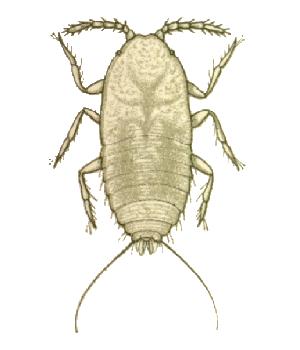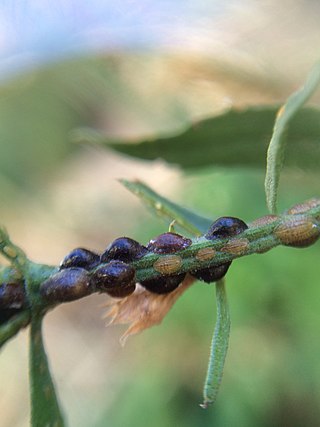
Mealybugs are insects in the family Pseudococcidae, unarmored scale insects found in moist, warm habitats. Many species are considered pests as they feed on plant juices of greenhouse plants, house plants and subtropical trees and also act as a vector for several plant diseases. Some ants live in symbiotic relationships with them, protecting them from predators and feeding off the honeydew which they excrete.

Pseudococcus viburni is a close relative of the grape mealybug and a pest of the vineyards around the world.

Cryptolaemus montrouzieri, common name mealybug ladybird or mealybug destroyer, is a species of ladybird beetle native to eastern Australia. The beetle feeds on mealybugs and other scale insects, and is used to control those pests on citrus orchards worldwide.

Pseudococcus is a genus of unarmoured scale insects in the family Pseudococcidae, the mealy bugs. There are more than 150 species of Pseudococcus.

Deraeocoris is a genus of plant bugs in the family Miridae. There are at least 210 described species in Deraeocoris.
Grapevine virus A (GVA) is a moderately common genetic virus that affects Vitis vinifera and American Vitis grapevine species throughout the world and can be fatal if not treated. Grapevine virus A is in the family Betaflexiviridae and genus Vitivirus. The common name for this virus is grapevine closterovirus. Common symptoms in infected grapevines include stem pitting. Although there is a treatment available to cure infected grapevines, it is not one hundred percent effective, so preventative measures are the best solution to the virus. Every inhabited continent on the globe has had breakouts of grapevine closterovirus due to the complex genetic makeup of the virus. Grapevine virus A has a single-stranded RNA genome, which is similar to that of Grapevine virus B. There are multiple strains of the virus that vary both molecularly and biologically which account for the slightly different symptoms exhibited by infected plants.

Hyalymenus is a genus of broad-headed bugs in the family Alydidae. There are about 6 described species in Hyalymenus.

Dysmicoccus is a genus of scales and mealybugs in the family Pseudococcidae. There are at least 110 described species in Dysmicoccus.

Saissetia coffeae, known generally as hemispherical scale, is a species of soft scale insect in the family Coccidae. Other common names include the helmet scale and coffee brown scale.
Saissetia is a genus of soft scale insects in the family Coccidae. There are at least four described species in Saissetia.

Lepidosaphes is a genus of scales and mealybugs in the family Diaspididae. There are at least 150 described species in Lepidosaphes.
Hemiberlesia is a genus of scales and mealybugs in the family Diaspididae. There are at least 30 described species in Hemiberlesia.

Antonina graminis or Rhodes grass scale is a species of mealybug in the family Pseudococcidae. In the 1940s the species, originating in Asia, infested nearly 69 species fodder and turf grasses in Texas causing major economic loss. Classical biological control was made use of in the 1950s and 60s with nearly complete control achieved after the aerial introduction of a wingless encyrtid parasite from India, Neodusmetia sangwani. By 1976 the control was a complete success and nearly 17 million USD was estimated as savings due to the parasite.

Aspidiotus destructor, the coconut scale, is a species of armoured scale insect in the family Diaspididae, found in many tropical and subtropical parts of the world. It is a serious pest of coconut and banana, and attacks a range of other fruiting trees and ornamental plants.
Chrysomphalus is a genus of scales and mealybugs in the family Diaspididae. There are about 16 described species in Chrysomphalus.

Unaspis citri, known generally as citrus snow scale, is a species of armored scale insect in the family Diaspididae. Other common names include the orange chionaspi, orange snow scale, white louse scale, and white snow scale.

Unaspis is a genus of armored scale insects in the family Diaspididae. There are at least two described species in Unaspis.

Parasaissetia is a genus of scales and mealybugs in the family Coccidae. There are about five described species in Parasaissetia.
Antonina is a genus of mealybugs in the family Pseudococcidae. There are at least three described species in Antonina.

Pseudococcus comstocki, common name Comstock mealybug, is a species of mealybug. The species was first discovered in 1902 in Japan. It is an invasive pest species that feeds on fruit and plants.















